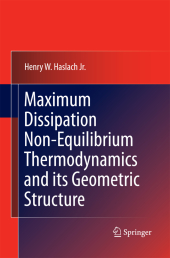 Neuerscheinungen 2014Stand: 2020-02-01 |
Schnellsuche
ISBN/Stichwort/Autor
|
Herderstraße 10
10625 Berlin
Tel.: 030 315 714 16
Fax 030 315 714 14
info@buchspektrum.de |

Henry W. Haslach
Maximum Dissipation Non-Equilibrium Thermodynamics and its Geometric Structure
2011. 2014. xiv, 297 S. 235 mm
Verlag/Jahr: SPRINGER, BERLIN; SPRINGER NEW YORK; SPRINGER 2014
ISBN: 1-489-98174-8 (1489981748)
Neue ISBN: 978-1-489-98174-5 (9781489981745)
Preis und Lieferzeit: Bitte klicken
This book explores the thermodynamics of non-equilibrium processes in materials. It develops a general technique created in order to construct nonlinear evolution equations describing non-equilibrium processes, while also developing a geometric context.
Maximum Dissipation: Non-Equilibrium Thermodynamics and its Geometric Structure explores the thermodynamics of non-equilibrium processes in materials. The book develops a general technique created in order to construct nonlinear evolution equations describing non-equilibrium processes, while also developing a geometric context for non-equilibrium thermodynamics. Solid materials are the main focus in this volume, but the construction is shown to also apply to fluids. This volume also:
- Explains the theory behind thermodynamically-consistent construction of non-linear evolution equations for non-equilibrium processes
- Provides a geometric setting for non-equilibrium thermodynamics through several standard models, which are defined as maximum dissipation processes
- Emphasizes applications to the time-dependent modeling of soft biological tissue
Maximum Dissipation: Non-Equilibrium Thermodynamics and its Geometric Structure will be valuable for researchers, engineers and graduate students in non-equilibrium thermodynamics and the mathematical modeling of material behavior.
History of Non-Equilibrium Thermodynamics.- Energy Methods.- Evolution Construction for Homogeneous Thermodynamic Systems.- Viscoelasticity.- Viscoplasticity.- The Thermodynamic Relaxation Modulus as a Multi-scale Bridge from the Atomic Level to the Bulk Material.- Contact Geometric Structure for Non-equilibrium Thermodynamics. Bifurcations in the Generalized Energy Function.- Evolution Construction for Non-homogeneous Thermodynamic Systems.- Electromagnetism and Joule Heating.- Fracture.
From the reviews:
"The author presents his construction of a geometric model for non-equilibrium thermodynamics and his maximum dissipation criterion which is assumed to complement the second law of thermodynamics. ... the author explores different concrete situations where his construction of a maximum dissipation criterion may be applied. ... This book will be interesting for researchers involved either in applied mathematics or in mechanics." (Alain Brillard, Zentralblatt MATH, Vol. 1222, 2011)


